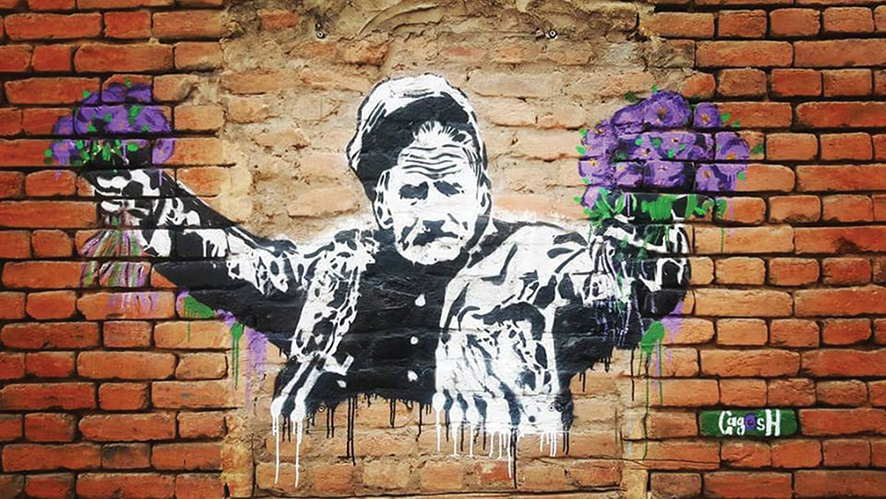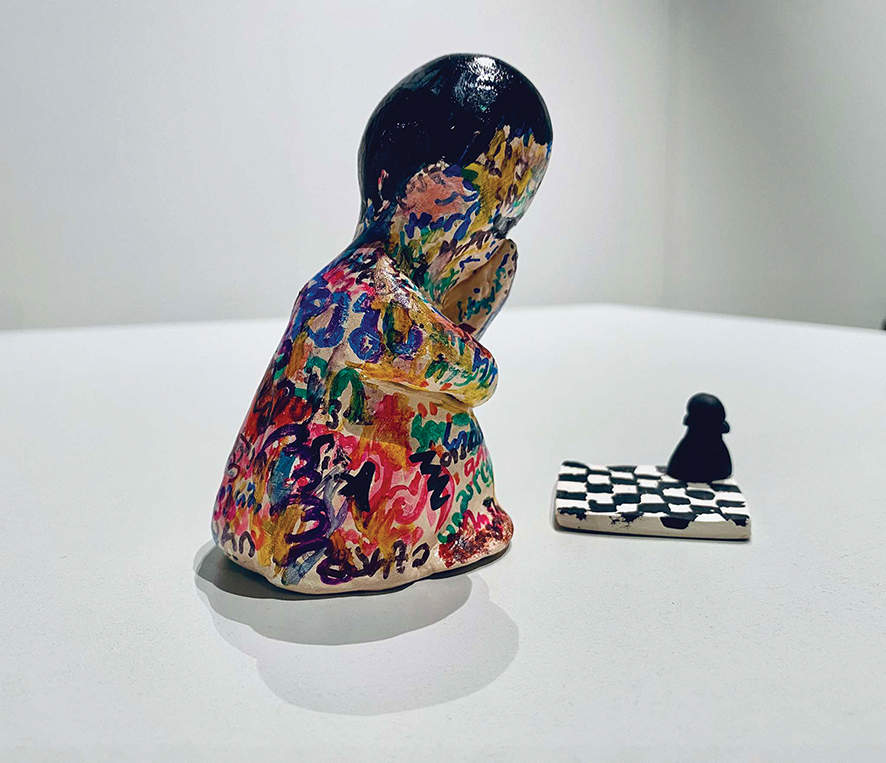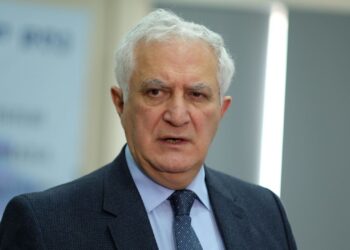Often called the “Georgian Banksy,” Giorgi Gagoshidze—known as Gagosh—is one of Georgia’s first widely recognized street artists. His sharp, thought-provoking images are found all over Tbilisi, lingering in the mind and sparking conversations. Last week, his mixed-media miniatures were sold in Bonhams’ first-ever auction dedicated to Georgian contemporary art.
In this candid interview, Gagosh shares his approach to blending text and image, the role of street art in political and social protest, and his perspective on Georgia’s evolving creative scene. He also reflects on how art, humor, and resistance shape not just his practice but his worldview.
Your work often appears directly in public spaces, engaging with urgent social and political themes. What draws you to street art as your primary medium for these powerful messages?
I see walls as open canvases—public forums where people can voice their thoughts, frustrations, and hopes. For me, street art isn’t just about painting; it’s about provoking thought and sparking dialogue. In many ways, today’s street artist plays a role similar to that of the ancient philosopher—walking among people, asking difficult questions, challenging the status quo, and urging society to confront what it would rather overlook.
Through my work, I strive to bring taboo or stigmatized topics into the public eye—whether political, social, or environmental. That, to me, is the responsibility of the street artist: to ensure art exists where life happens—not hidden in galleries, but visible, persistent, and impossible to ignore.
You address a broad spectrum of themes—from urban green spaces and labor rights to gender equality and the Russian occupation. Is there a common thread or core motivation guiding your choice of subjects?
I see art as a tool—a way to speak about everyday life with honesty and urgency. My inspiration comes directly from the challenges we face day to day, so my themes shift as society shifts. That’s why I believe a street artist must keep their hand on the pulse of the people. Street art, at its core, is about presence—being among the people, listening, reflecting, and responding. It’s not just about making images; it’s about being a responsible citizen through art.

Your style often combines striking imagery with text, sometimes in a very poetic or even childlike script. Could you talk about the interplay between the visual and the textual in your work, and how you develop these distinctive phrases?
I’ve always loved poetry, and at first, I tried writing full poems on walls. But I soon realized that street poetry needs a different form. It has to be short, sharp, ironic—something a passerby can catch in a single glance, yet something that lingers in their mind like a tune. It should provoke curiosity and invite decoding the hidden message beneath the irony.
Sometimes I create stencils resembling tear-off flyers—the kind people usually use to advertise tutoring or moving services. Except mine might say something political or social, for instance, “Poor country for sale at a good location. Renovation needed.” I add my own number, just like in real ads, inviting people to call me. It’s part of my practice. I want to blur the line between art and everyday life. Because, to me, art isn’t just a statement from the artist—it’s an invitation to a conversation with the public.
Your academic background is in computer science and technology administration. How, if at all, do these fields influence your artistic practice, particularly your interest in integrating art with IT and new media techniques?
Technology can enhance street art, but for me, the heart of it remains the same: engagement with society. The goal is always to start a conversation, to create a moment of connection—and technology can deepen that connection in surprising ways.
I’ve experimented with this in a few projects. One example is the Talking Wall. I installed hidden sensors and a sound system in a wall in old Tbilisi. As people walked by, the system would randomly select someone and invite them to listen to poetry. If they ignored it and walked away, the wall would start whining. But if they stopped and listened, the wall would recite different poems aloud.
It was a playful, even surreal experience. People would look around, searching for who was talking to them, only to realize—it was the wall itself. The sensors were nearly invisible, so the interaction felt magical, like the city was whispering something personal.
That’s what excites me: using technology not to replace the human aspect of art, but to amplify it—to create unexpected moments that invite reflection, curiosity, and connection.
Many of your pieces—such as the Wall of August or your stencils protesting the “creeping occupation”—are direct responses to painful and ongoing political realities in Georgia. What role do you believe art, and street art in particular, can play in times of national trauma or in fostering political discourse?
Street art has long been part of political discourse, and one of its most powerful qualities is its accessibility—you don’t need to be a trained artist to take part. All you need is a strong concept and the courage to put it out there.
During the Tbilisi protests, I was deeply moved by people’s creativity. Walls and banners became platforms of protest. Each message reflected irony through the lens of different professions, regions, religious, and ethnic identities. It was raw, diverse, and honest—a true portrait of collective resistance.
That inspired me to create a New Year’s project. I put out a call on social media, asking people to send in the banners they had made during the protests. Then, on New Year’s Eve, I created a stencil on Freedom Square: a New Year’s tree made from those protest banners.
It was both a celebration and a reminder—that hope and resistance often grow from the same root. For me, this is what street art should be: a space where voices come together, and where art meets activism.

While much of your work lives in the public domain, you’ve also exhibited in gallery settings. How does the experience of creating and presenting work for a gallery differ from making art for the street—and does the change in context alter the meaning of the work for you?
Street art and canvas work follow very different rhythms. Street art is fast, raw, and unpredictable—it starts with finding the right wall, prepping a stencil, and working quickly, often under pressure. There’s adrenaline in it, a poetic urgency. It’s imperfect but alive.
Canvas, by contrast, offers time and space for reflection. Even with the same themes, the process is slower, more deliberate. You can sit with the piece, refine it, and think through each detail.
I enjoy both. Street art is public, fleeting, bold. Canvas is internal, precise, contemplative. They let me explore the same truths—one through action, the other through reflection.
Looking at the current Georgian art scene—especially among younger artists or those working outside traditional institutions—what trends or energies do you find most exciting or most concerning?
I see street art as a cultural pulse—especially the spontaneous messages written by ordinary citizens. There’s raw energy in those unfiltered expressions; they reveal what people truly feel, in real time.
What concerns me is the growing commercialization of street art. Large-scale murals, often curated, are becoming more decorative than critical. Beautifying public space has value, but for me, street art is closer to conceptual protest than visual ornament.
It’s meant to provoke, not just please. When it’s reduced to aesthetic filler, it loses its edge—and its soul.
If you could install one piece of your art anywhere in the world, with no restrictions, what would it be and where would you place it to achieve its maximum intended impact?
It’s difficult to choose one work, as each subject I explore—migration, eviction, Russian occupation, femicide, labor rights, environmental justice—is deeply important. But if I had to pick, I’d choose a piece from my series on the old man selling violets.
To Georgians, he’s a familiar sign of spring, but to me, he symbolizes something deeper: a kind of metaphysical spring. Amid daily struggles, when people pass by this image, I want it to quietly remind them that spring—hope, renewal, beauty—is still here.
It’s not just about flowers. It’s about resilience. The violet seller is a gentle, human resistance to despair. If someone feels even a flicker of warmth or reflection from it, the piece has done its work.














